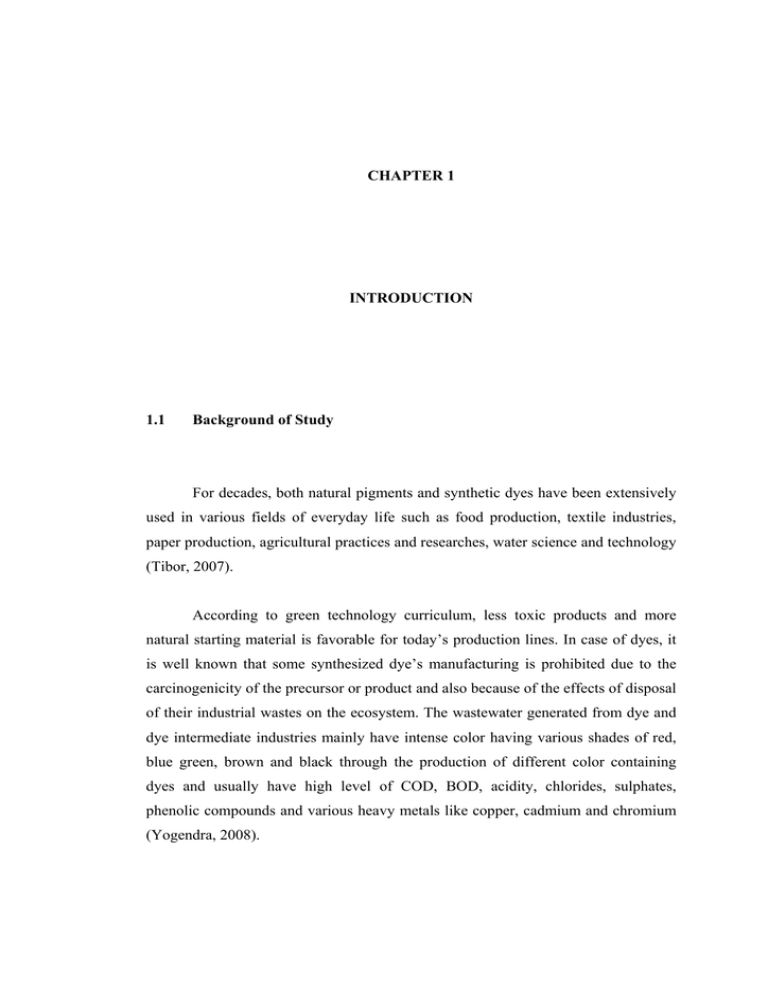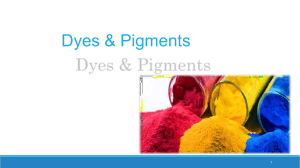CHAPTER 1 INTRODUCTION 1.1
advertisement

CHAPTER 1 INTRODUCTION 1.1 Background of Study For decades, both natural pigments and synthetic dyes have been extensively used in various fields of everyday life such as food production, textile industries, paper production, agricultural practices and researches, water science and technology (Tibor, 2007). According to green technology curriculum, less toxic products and more natural starting material is favorable for today’s production lines. In case of dyes, it is well known that some synthesized dye’s manufacturing is prohibited due to the carcinogenicity of the precursor or product and also because of the effects of disposal of their industrial wastes on the ecosystem. The wastewater generated from dye and dye intermediate industries mainly have intense color having various shades of red, blue green, brown and black through the production of different color containing dyes and usually have high level of COD, BOD, acidity, chlorides, sulphates, phenolic compounds and various heavy metals like copper, cadmium and chromium (Yogendra, 2008). 2 Dyes, as they are intensively colored, cause special problems in effluent discharge (even small amount is noticeable). The effect is aesthetically more displeasing rather than hazardous, and can prevent sunlight penetration decreasing photosynthetic activity in aquatic environment. Although, some azo dyes that causes the effluent color have been implicated as being mutagenic/carcinogenic as well as toxic to aquatic life (Yogendra, 2008). Thus, extensive research has been conducted to find alternative dyes whose production and use would meet high environmental and safety requirements (Georgeta et al, 2004). Increasingly, with the improvements in fermentation and other biotechnological techniques, bacteria, single-celled fungi and protozoa offer considerable scope for the commercial production of many pigments. There are many source of natural pigments which are derived from plants, animal, fungi and bacteria. Several intensely colored compounds have been isolated from certain bacteria which have resemblance to pigments in other biological systems (Britton, 1983). Indigoidine or bacterial indigo, a dimeric pyridine structurally unrelated to the indigo of plants, is found in Pseudomonas indigofera. The highly pigmented Chromobacterium has also yielded the dark antibiotic prodigiosin with almost uncommon structure, a trimeric pyrrole (Hendry and Houghton, 1996). The same genus also produces dimeric indoles such as the purple violacein pigment, although this one has, at least, some resemblance to the indole derivatives of higher plants (Hendry and Houghton, 1996). Natural pigments not only have the capacity to increase the marketability of products, they also display advantageous biological activities as antioxidants and anticancer agents. Synthetic pigments, on the other hand, cause considerably environmental pollution and adverse toxicological side effects. Both classes of pigment exhibit considerable structural diversity (Tibor, 2007). 3 1.2 Statement of Problem The use of synthetic dye has several disadvantages amongst them are carcinogenicity, ambient pollution possibility and increase of the cutaneous allergies for the user of the product. Green technology is leading all producers to go towards ecological and less polluted products with fewer by-products; in the case of synthesized dye, natural pigments can be considered as an ideal alternative. The most important issue regarding natural pigment is the price of final product which is more expensive than cheap synthesized dye. In this research possibility of using cheap growth media (agricultural wastes) such as Solid Pineapple Waste (SPW) and Brown Sugar (BS) which leads to inexpensive and competitive product, have been studied. 1.2 Objectives and Scope of Study The objective of this study is to extract the purple pigment, violacein, from Chromobacterium violaceum which was grown on SPW and BS. The characterization of the pigment was made using UV-VIS spectrophotometer, IR, and NMR. 4 1.3 Significance of Study This study aims at introducing bacterial pigments as an alternative to synthetic dye. In this study cheap medium were employed for bacterial growth and the simplest method for bacterial pigment extraction was developed to overcome the higher price of natural pigments compare to synthesized dye.



